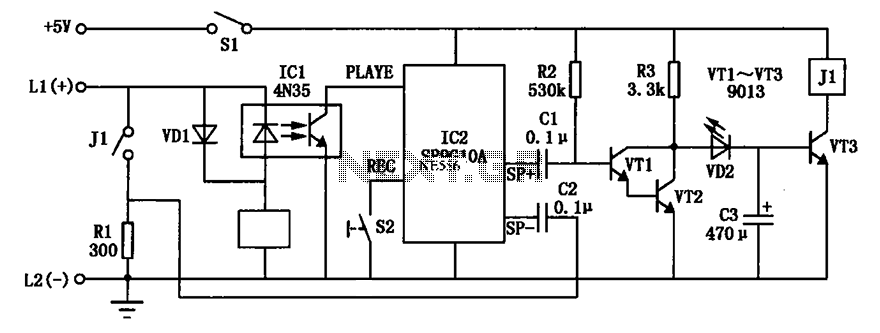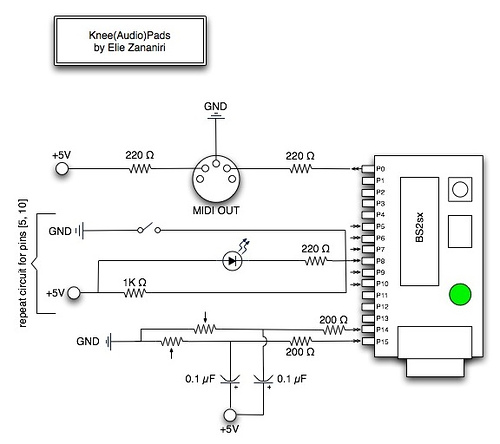
555 fall means a circuit diagram for help

The call is triggered by the position sensing circuit, which activates the control circuit and SOS alarm circuit. This system is designed for critically ill patients or to assist disabled individuals in the event of a fall. A position sensor, housed in a chest pocket, includes a mercury switch positioned horizontally. When a fall occurs, contacts A and B become electrically conductive due to the mercury, activating C1. This causes VT1 to conduct, pulling J1 and turning on the power supply circuit to emit a sound for help. The components IC1, R1, RP1, and C1 form an astable multivibrator with an oscillation period of approximately one second. The charging and discharging of capacitor C1 generates a triangular wave, which is fed into a controllable multivibrator IC2. IC2 produces a variable control voltage that generates a sound similar to an ambulance siren.
The electronic schematic described involves multiple circuits working in tandem to ensure rapid response in emergencies. The position sensing circuit utilizes a mercury switch to detect a fall. This switch is designed to close the circuit when the sensor is tilted beyond a certain angle, indicating a fall. The circuit includes two main contacts, A and B, which become conductive when the mercury flows to complete the circuit.
Upon activation, the circuit charges capacitor C1, which is part of an astable multivibrator configuration. This multivibrator is critical for generating a consistent oscillation period, set to approximately one second, allowing for a reliable timing mechanism that can be used to generate repeated signals. The charging and discharging of C1 create a triangular waveform, which is essential for the next stage of the circuit.
The output from the astable multivibrator is fed into a transistor (VT1), which acts as a switch to control the power supply to the alarm system. When VT1 is activated, it pulls the relay (J1), which connects the power supply to the sound-emitting device. This device is designed to produce a loud sound to alert others for help.
The second stage of the circuit involves IC2, a controllable multivibrator that takes the output from the astable multivibrator. This IC is designed to modulate the control voltage based on the input it receives, allowing it to generate sounds that mimic an ambulance siren. This feature is particularly useful in emergency situations, as it can attract immediate attention.
Overall, the system is a critical tool for ensuring the safety of individuals who may be at risk of falling, providing a reliable means of alerting caregivers or emergency responders. The integration of position sensing, timing circuits, and sound generation in a compact design makes it an effective solution for fall detection and emergency signaling. As shown, the call falls by the position sensing circuit trigger control circuit and SOS alarm circuit. For critically ill patients or for help with a disabled person falls. Pa tients with chest pocket position sensor placed inside the box with a mercury switch, horizontal. When the fall, A, B two contacts are electrically conductive mercury ON, C1 immediately charged, VT1 conduction, J1 pull, the power supply circuit is turned on the sound, so the sound rang for help. IC1 and R1, RP1, C1 composition astable multivibrator oscillation period transferred to T 1 second. Charging and discharging the capacitor C1 to form a triangular wave VT1, the emitter follower output added to the controllable multivibrator IC2, the IC2 with the change in control voltage issued a similar message called an ambulance sound.
The electronic schematic described involves multiple circuits working in tandem to ensure rapid response in emergencies. The position sensing circuit utilizes a mercury switch to detect a fall. This switch is designed to close the circuit when the sensor is tilted beyond a certain angle, indicating a fall. The circuit includes two main contacts, A and B, which become conductive when the mercury flows to complete the circuit.
Upon activation, the circuit charges capacitor C1, which is part of an astable multivibrator configuration. This multivibrator is critical for generating a consistent oscillation period, set to approximately one second, allowing for a reliable timing mechanism that can be used to generate repeated signals. The charging and discharging of C1 create a triangular waveform, which is essential for the next stage of the circuit.
The output from the astable multivibrator is fed into a transistor (VT1), which acts as a switch to control the power supply to the alarm system. When VT1 is activated, it pulls the relay (J1), which connects the power supply to the sound-emitting device. This device is designed to produce a loud sound to alert others for help.
The second stage of the circuit involves IC2, a controllable multivibrator that takes the output from the astable multivibrator. This IC is designed to modulate the control voltage based on the input it receives, allowing it to generate sounds that mimic an ambulance siren. This feature is particularly useful in emergency situations, as it can attract immediate attention.
Overall, the system is a critical tool for ensuring the safety of individuals who may be at risk of falling, providing a reliable means of alerting caregivers or emergency responders. The integration of position sensing, timing circuits, and sound generation in a compact design makes it an effective solution for fall detection and emergency signaling. As shown, the call falls by the position sensing circuit trigger control circuit and SOS alarm circuit. For critically ill patients or for help with a disabled person falls. Pa tients with chest pocket position sensor placed inside the box with a mercury switch, horizontal. When the fall, A, B two contacts are electrically conductive mercury ON, C1 immediately charged, VT1 conduction, J1 pull, the power supply circuit is turned on the sound, so the sound rang for help. IC1 and R1, RP1, C1 composition astable multivibrator oscillation period transferred to T 1 second. Charging and discharging the capacitor C1 to form a triangular wave VT1, the emitter follower output added to the controllable multivibrator IC2, the IC2 with the change in control voltage issued a similar message called an ambulance sound.





